Communication in Business: Chinese Business Etiquette and Cross-Cultural Miscommunication
VerifiedAdded on 2023/06/13
|6
|2174
|100
AI Summary
The study aims to highlight the Chinese business etiquette and the steps that Mary can utilise for taking a favourable first impression when the person visits China to meet Mr Lau. The purpose of the study is to include the areas of potential cross-cultural miscommunication by utilising the cultural framework of Hofstede. In addition to this, the study will provide significant recommendations so that, it becomes possible for Mary to increase the chances of success of the meeting.
Contribute Materials
Your contribution can guide someone’s learning journey. Share your
documents today.
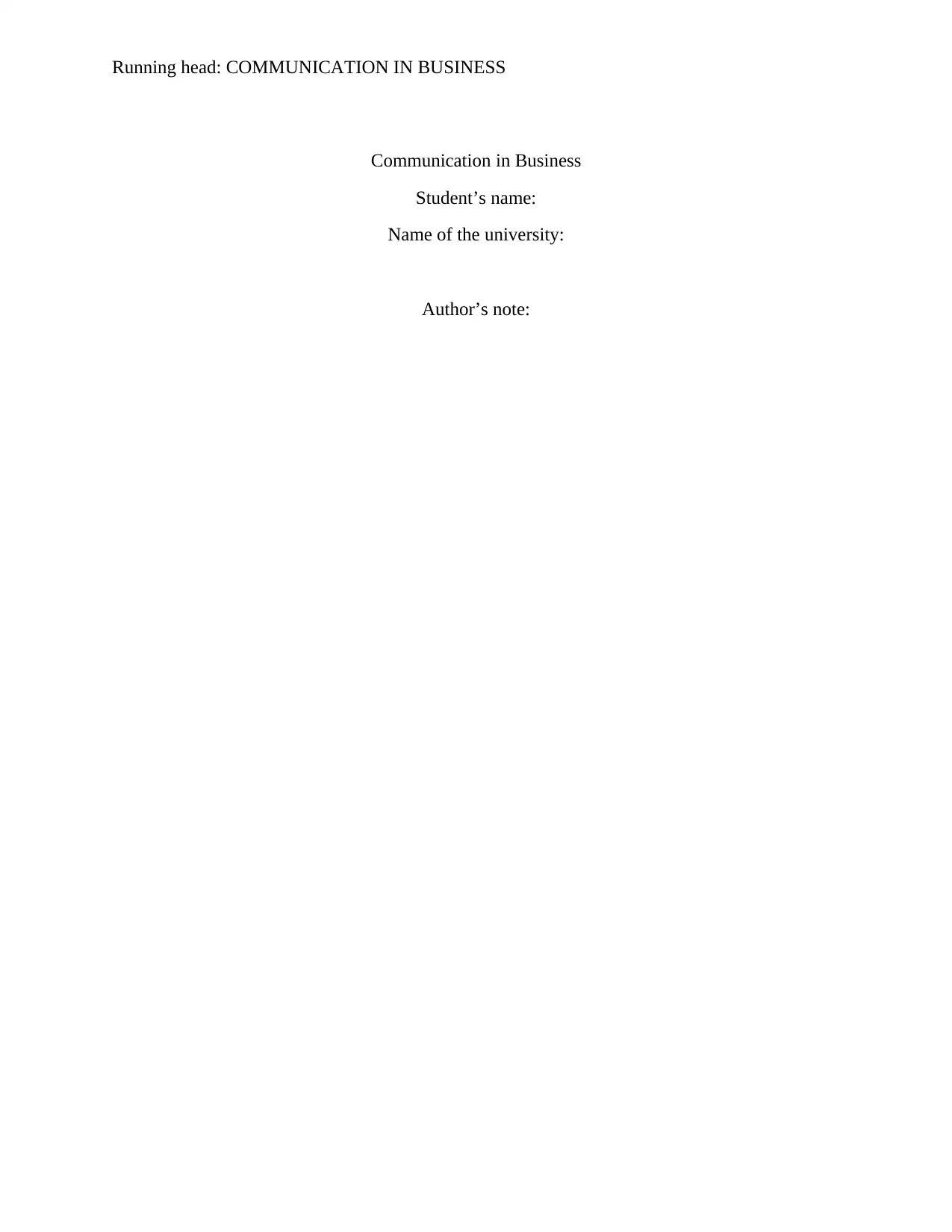
Running head: COMMUNICATION IN BUSINESS
Communication in Business
Student’s name:
Name of the university:
Author’s note:
Communication in Business
Student’s name:
Name of the university:
Author’s note:
Secure Best Marks with AI Grader
Need help grading? Try our AI Grader for instant feedback on your assignments.
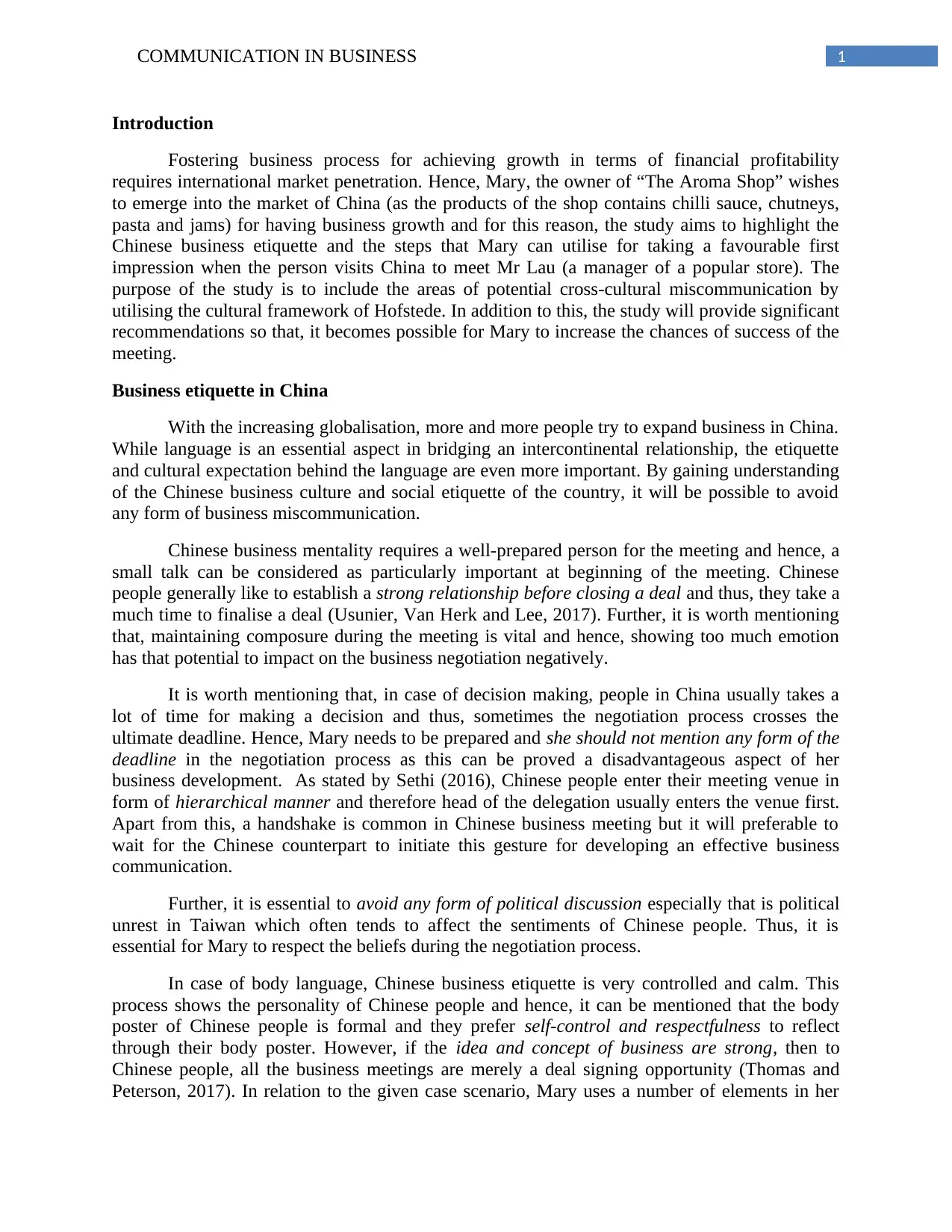
1COMMUNICATION IN BUSINESS
Introduction
Fostering business process for achieving growth in terms of financial profitability
requires international market penetration. Hence, Mary, the owner of “The Aroma Shop” wishes
to emerge into the market of China (as the products of the shop contains chilli sauce, chutneys,
pasta and jams) for having business growth and for this reason, the study aims to highlight the
Chinese business etiquette and the steps that Mary can utilise for taking a favourable first
impression when the person visits China to meet Mr Lau (a manager of a popular store). The
purpose of the study is to include the areas of potential cross-cultural miscommunication by
utilising the cultural framework of Hofstede. In addition to this, the study will provide significant
recommendations so that, it becomes possible for Mary to increase the chances of success of the
meeting.
Business etiquette in China
With the increasing globalisation, more and more people try to expand business in China.
While language is an essential aspect in bridging an intercontinental relationship, the etiquette
and cultural expectation behind the language are even more important. By gaining understanding
of the Chinese business culture and social etiquette of the country, it will be possible to avoid
any form of business miscommunication.
Chinese business mentality requires a well-prepared person for the meeting and hence, a
small talk can be considered as particularly important at beginning of the meeting. Chinese
people generally like to establish a strong relationship before closing a deal and thus, they take a
much time to finalise a deal (Usunier, Van Herk and Lee, 2017). Further, it is worth mentioning
that, maintaining composure during the meeting is vital and hence, showing too much emotion
has that potential to impact on the business negotiation negatively.
It is worth mentioning that, in case of decision making, people in China usually takes a
lot of time for making a decision and thus, sometimes the negotiation process crosses the
ultimate deadline. Hence, Mary needs to be prepared and she should not mention any form of the
deadline in the negotiation process as this can be proved a disadvantageous aspect of her
business development. As stated by Sethi (2016), Chinese people enter their meeting venue in
form of hierarchical manner and therefore head of the delegation usually enters the venue first.
Apart from this, a handshake is common in Chinese business meeting but it will preferable to
wait for the Chinese counterpart to initiate this gesture for developing an effective business
communication.
Further, it is essential to avoid any form of political discussion especially that is political
unrest in Taiwan which often tends to affect the sentiments of Chinese people. Thus, it is
essential for Mary to respect the beliefs during the negotiation process.
In case of body language, Chinese business etiquette is very controlled and calm. This
process shows the personality of Chinese people and hence, it can be mentioned that the body
poster of Chinese people is formal and they prefer self-control and respectfulness to reflect
through their body poster. However, if the idea and concept of business are strong, then to
Chinese people, all the business meetings are merely a deal signing opportunity (Thomas and
Peterson, 2017). In relation to the given case scenario, Mary uses a number of elements in her
Introduction
Fostering business process for achieving growth in terms of financial profitability
requires international market penetration. Hence, Mary, the owner of “The Aroma Shop” wishes
to emerge into the market of China (as the products of the shop contains chilli sauce, chutneys,
pasta and jams) for having business growth and for this reason, the study aims to highlight the
Chinese business etiquette and the steps that Mary can utilise for taking a favourable first
impression when the person visits China to meet Mr Lau (a manager of a popular store). The
purpose of the study is to include the areas of potential cross-cultural miscommunication by
utilising the cultural framework of Hofstede. In addition to this, the study will provide significant
recommendations so that, it becomes possible for Mary to increase the chances of success of the
meeting.
Business etiquette in China
With the increasing globalisation, more and more people try to expand business in China.
While language is an essential aspect in bridging an intercontinental relationship, the etiquette
and cultural expectation behind the language are even more important. By gaining understanding
of the Chinese business culture and social etiquette of the country, it will be possible to avoid
any form of business miscommunication.
Chinese business mentality requires a well-prepared person for the meeting and hence, a
small talk can be considered as particularly important at beginning of the meeting. Chinese
people generally like to establish a strong relationship before closing a deal and thus, they take a
much time to finalise a deal (Usunier, Van Herk and Lee, 2017). Further, it is worth mentioning
that, maintaining composure during the meeting is vital and hence, showing too much emotion
has that potential to impact on the business negotiation negatively.
It is worth mentioning that, in case of decision making, people in China usually takes a
lot of time for making a decision and thus, sometimes the negotiation process crosses the
ultimate deadline. Hence, Mary needs to be prepared and she should not mention any form of the
deadline in the negotiation process as this can be proved a disadvantageous aspect of her
business development. As stated by Sethi (2016), Chinese people enter their meeting venue in
form of hierarchical manner and therefore head of the delegation usually enters the venue first.
Apart from this, a handshake is common in Chinese business meeting but it will preferable to
wait for the Chinese counterpart to initiate this gesture for developing an effective business
communication.
Further, it is essential to avoid any form of political discussion especially that is political
unrest in Taiwan which often tends to affect the sentiments of Chinese people. Thus, it is
essential for Mary to respect the beliefs during the negotiation process.
In case of body language, Chinese business etiquette is very controlled and calm. This
process shows the personality of Chinese people and hence, it can be mentioned that the body
poster of Chinese people is formal and they prefer self-control and respectfulness to reflect
through their body poster. However, if the idea and concept of business are strong, then to
Chinese people, all the business meetings are merely a deal signing opportunity (Thomas and
Peterson, 2017). In relation to the given case scenario, Mary uses a number of elements in her
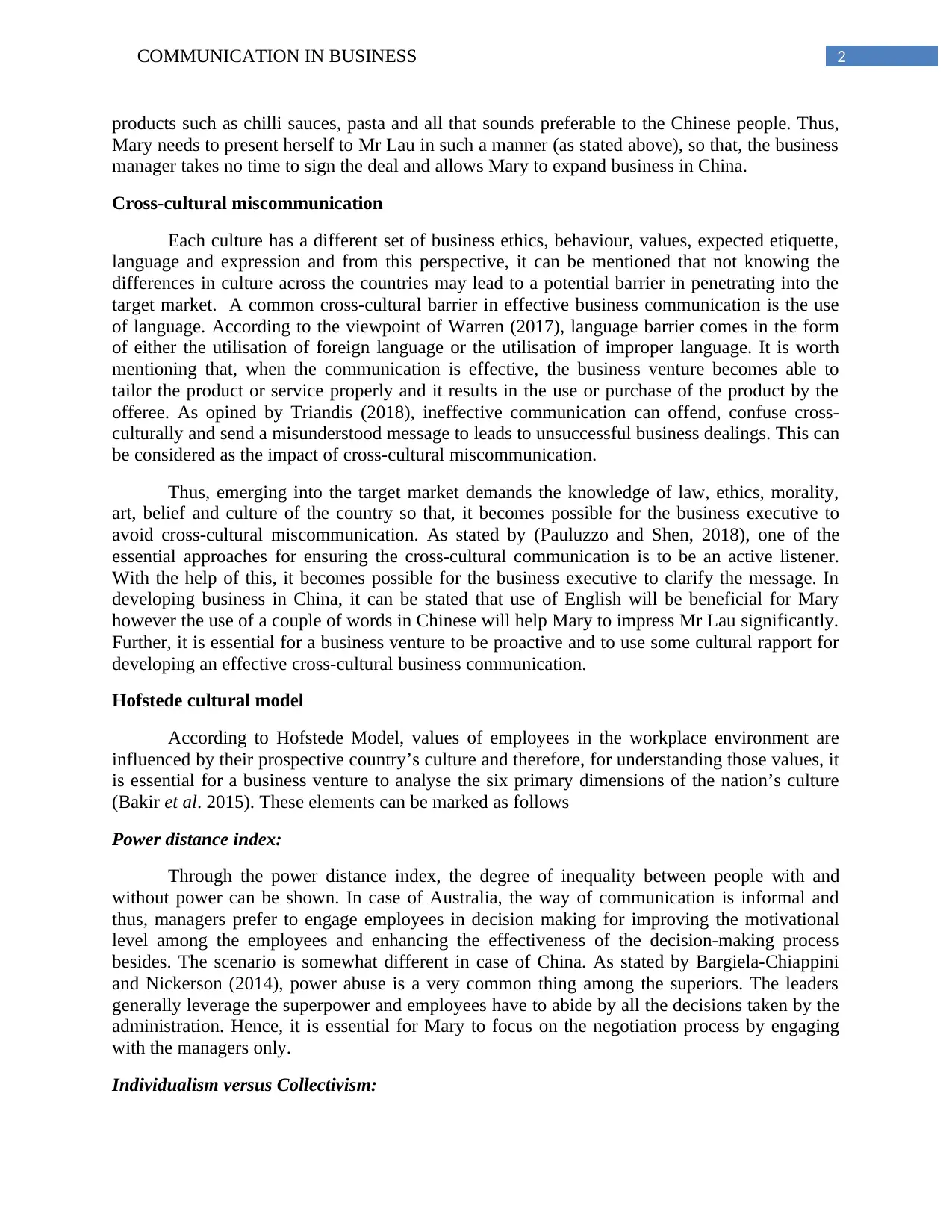
2COMMUNICATION IN BUSINESS
products such as chilli sauces, pasta and all that sounds preferable to the Chinese people. Thus,
Mary needs to present herself to Mr Lau in such a manner (as stated above), so that, the business
manager takes no time to sign the deal and allows Mary to expand business in China.
Cross-cultural miscommunication
Each culture has a different set of business ethics, behaviour, values, expected etiquette,
language and expression and from this perspective, it can be mentioned that not knowing the
differences in culture across the countries may lead to a potential barrier in penetrating into the
target market. A common cross-cultural barrier in effective business communication is the use
of language. According to the viewpoint of Warren (2017), language barrier comes in the form
of either the utilisation of foreign language or the utilisation of improper language. It is worth
mentioning that, when the communication is effective, the business venture becomes able to
tailor the product or service properly and it results in the use or purchase of the product by the
offeree. As opined by Triandis (2018), ineffective communication can offend, confuse cross-
culturally and send a misunderstood message to leads to unsuccessful business dealings. This can
be considered as the impact of cross-cultural miscommunication.
Thus, emerging into the target market demands the knowledge of law, ethics, morality,
art, belief and culture of the country so that, it becomes possible for the business executive to
avoid cross-cultural miscommunication. As stated by (Pauluzzo and Shen, 2018), one of the
essential approaches for ensuring the cross-cultural communication is to be an active listener.
With the help of this, it becomes possible for the business executive to clarify the message. In
developing business in China, it can be stated that use of English will be beneficial for Mary
however the use of a couple of words in Chinese will help Mary to impress Mr Lau significantly.
Further, it is essential for a business venture to be proactive and to use some cultural rapport for
developing an effective cross-cultural business communication.
Hofstede cultural model
According to Hofstede Model, values of employees in the workplace environment are
influenced by their prospective country’s culture and therefore, for understanding those values, it
is essential for a business venture to analyse the six primary dimensions of the nation’s culture
(Bakir et al. 2015). These elements can be marked as follows
Power distance index:
Through the power distance index, the degree of inequality between people with and
without power can be shown. In case of Australia, the way of communication is informal and
thus, managers prefer to engage employees in decision making for improving the motivational
level among the employees and enhancing the effectiveness of the decision-making process
besides. The scenario is somewhat different in case of China. As stated by Bargiela-Chiappini
and Nickerson (2014), power abuse is a very common thing among the superiors. The leaders
generally leverage the superpower and employees have to abide by all the decisions taken by the
administration. Hence, it is essential for Mary to focus on the negotiation process by engaging
with the managers only.
Individualism versus Collectivism:
products such as chilli sauces, pasta and all that sounds preferable to the Chinese people. Thus,
Mary needs to present herself to Mr Lau in such a manner (as stated above), so that, the business
manager takes no time to sign the deal and allows Mary to expand business in China.
Cross-cultural miscommunication
Each culture has a different set of business ethics, behaviour, values, expected etiquette,
language and expression and from this perspective, it can be mentioned that not knowing the
differences in culture across the countries may lead to a potential barrier in penetrating into the
target market. A common cross-cultural barrier in effective business communication is the use
of language. According to the viewpoint of Warren (2017), language barrier comes in the form
of either the utilisation of foreign language or the utilisation of improper language. It is worth
mentioning that, when the communication is effective, the business venture becomes able to
tailor the product or service properly and it results in the use or purchase of the product by the
offeree. As opined by Triandis (2018), ineffective communication can offend, confuse cross-
culturally and send a misunderstood message to leads to unsuccessful business dealings. This can
be considered as the impact of cross-cultural miscommunication.
Thus, emerging into the target market demands the knowledge of law, ethics, morality,
art, belief and culture of the country so that, it becomes possible for the business executive to
avoid cross-cultural miscommunication. As stated by (Pauluzzo and Shen, 2018), one of the
essential approaches for ensuring the cross-cultural communication is to be an active listener.
With the help of this, it becomes possible for the business executive to clarify the message. In
developing business in China, it can be stated that use of English will be beneficial for Mary
however the use of a couple of words in Chinese will help Mary to impress Mr Lau significantly.
Further, it is essential for a business venture to be proactive and to use some cultural rapport for
developing an effective cross-cultural business communication.
Hofstede cultural model
According to Hofstede Model, values of employees in the workplace environment are
influenced by their prospective country’s culture and therefore, for understanding those values, it
is essential for a business venture to analyse the six primary dimensions of the nation’s culture
(Bakir et al. 2015). These elements can be marked as follows
Power distance index:
Through the power distance index, the degree of inequality between people with and
without power can be shown. In case of Australia, the way of communication is informal and
thus, managers prefer to engage employees in decision making for improving the motivational
level among the employees and enhancing the effectiveness of the decision-making process
besides. The scenario is somewhat different in case of China. As stated by Bargiela-Chiappini
and Nickerson (2014), power abuse is a very common thing among the superiors. The leaders
generally leverage the superpower and employees have to abide by all the decisions taken by the
administration. Hence, it is essential for Mary to focus on the negotiation process by engaging
with the managers only.
Individualism versus Collectivism:
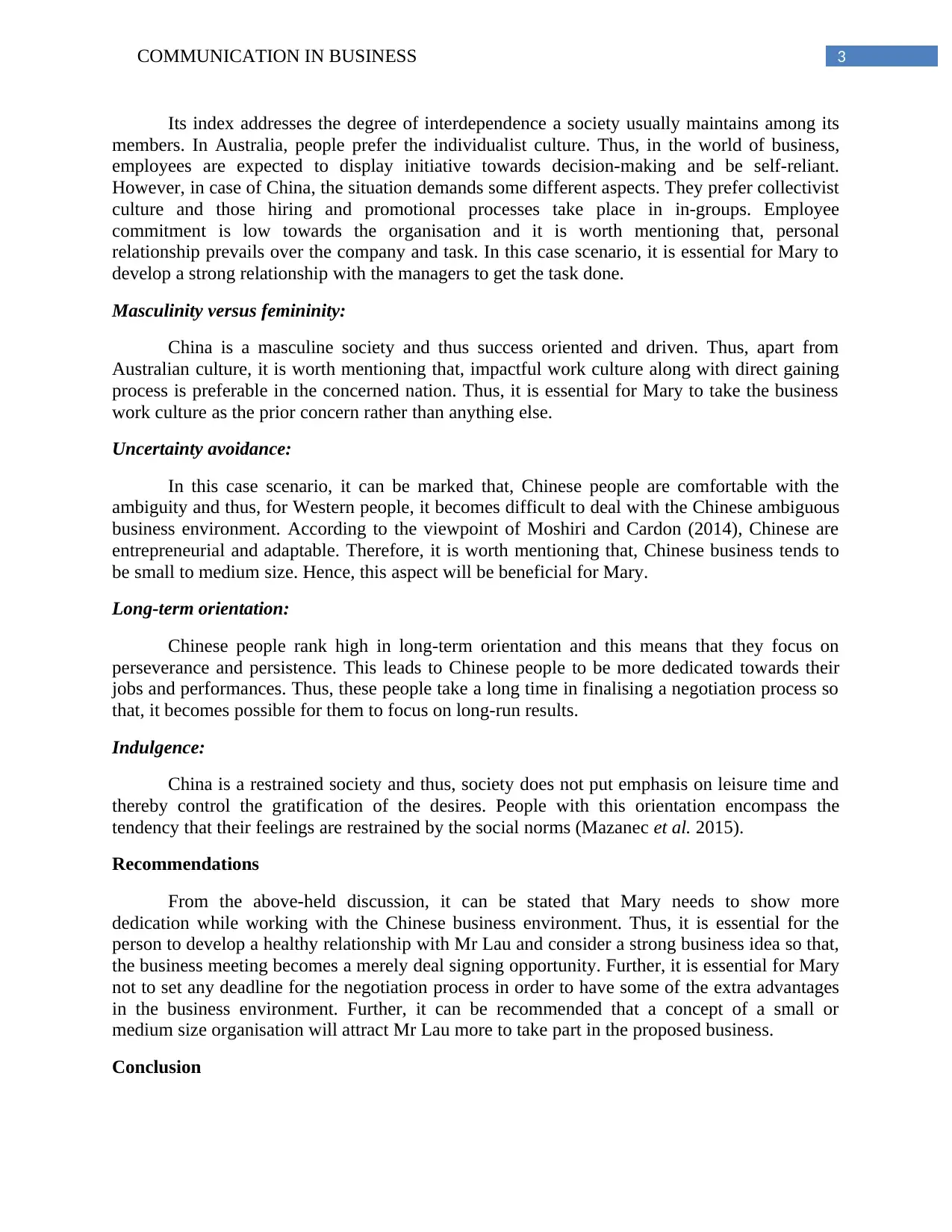
3COMMUNICATION IN BUSINESS
Its index addresses the degree of interdependence a society usually maintains among its
members. In Australia, people prefer the individualist culture. Thus, in the world of business,
employees are expected to display initiative towards decision-making and be self-reliant.
However, in case of China, the situation demands some different aspects. They prefer collectivist
culture and those hiring and promotional processes take place in in-groups. Employee
commitment is low towards the organisation and it is worth mentioning that, personal
relationship prevails over the company and task. In this case scenario, it is essential for Mary to
develop a strong relationship with the managers to get the task done.
Masculinity versus femininity:
China is a masculine society and thus success oriented and driven. Thus, apart from
Australian culture, it is worth mentioning that, impactful work culture along with direct gaining
process is preferable in the concerned nation. Thus, it is essential for Mary to take the business
work culture as the prior concern rather than anything else.
Uncertainty avoidance:
In this case scenario, it can be marked that, Chinese people are comfortable with the
ambiguity and thus, for Western people, it becomes difficult to deal with the Chinese ambiguous
business environment. According to the viewpoint of Moshiri and Cardon (2014), Chinese are
entrepreneurial and adaptable. Therefore, it is worth mentioning that, Chinese business tends to
be small to medium size. Hence, this aspect will be beneficial for Mary.
Long-term orientation:
Chinese people rank high in long-term orientation and this means that they focus on
perseverance and persistence. This leads to Chinese people to be more dedicated towards their
jobs and performances. Thus, these people take a long time in finalising a negotiation process so
that, it becomes possible for them to focus on long-run results.
Indulgence:
China is a restrained society and thus, society does not put emphasis on leisure time and
thereby control the gratification of the desires. People with this orientation encompass the
tendency that their feelings are restrained by the social norms (Mazanec et al. 2015).
Recommendations
From the above-held discussion, it can be stated that Mary needs to show more
dedication while working with the Chinese business environment. Thus, it is essential for the
person to develop a healthy relationship with Mr Lau and consider a strong business idea so that,
the business meeting becomes a merely deal signing opportunity. Further, it is essential for Mary
not to set any deadline for the negotiation process in order to have some of the extra advantages
in the business environment. Further, it can be recommended that a concept of a small or
medium size organisation will attract Mr Lau more to take part in the proposed business.
Conclusion
Its index addresses the degree of interdependence a society usually maintains among its
members. In Australia, people prefer the individualist culture. Thus, in the world of business,
employees are expected to display initiative towards decision-making and be self-reliant.
However, in case of China, the situation demands some different aspects. They prefer collectivist
culture and those hiring and promotional processes take place in in-groups. Employee
commitment is low towards the organisation and it is worth mentioning that, personal
relationship prevails over the company and task. In this case scenario, it is essential for Mary to
develop a strong relationship with the managers to get the task done.
Masculinity versus femininity:
China is a masculine society and thus success oriented and driven. Thus, apart from
Australian culture, it is worth mentioning that, impactful work culture along with direct gaining
process is preferable in the concerned nation. Thus, it is essential for Mary to take the business
work culture as the prior concern rather than anything else.
Uncertainty avoidance:
In this case scenario, it can be marked that, Chinese people are comfortable with the
ambiguity and thus, for Western people, it becomes difficult to deal with the Chinese ambiguous
business environment. According to the viewpoint of Moshiri and Cardon (2014), Chinese are
entrepreneurial and adaptable. Therefore, it is worth mentioning that, Chinese business tends to
be small to medium size. Hence, this aspect will be beneficial for Mary.
Long-term orientation:
Chinese people rank high in long-term orientation and this means that they focus on
perseverance and persistence. This leads to Chinese people to be more dedicated towards their
jobs and performances. Thus, these people take a long time in finalising a negotiation process so
that, it becomes possible for them to focus on long-run results.
Indulgence:
China is a restrained society and thus, society does not put emphasis on leisure time and
thereby control the gratification of the desires. People with this orientation encompass the
tendency that their feelings are restrained by the social norms (Mazanec et al. 2015).
Recommendations
From the above-held discussion, it can be stated that Mary needs to show more
dedication while working with the Chinese business environment. Thus, it is essential for the
person to develop a healthy relationship with Mr Lau and consider a strong business idea so that,
the business meeting becomes a merely deal signing opportunity. Further, it is essential for Mary
not to set any deadline for the negotiation process in order to have some of the extra advantages
in the business environment. Further, it can be recommended that a concept of a small or
medium size organisation will attract Mr Lau more to take part in the proposed business.
Conclusion
Secure Best Marks with AI Grader
Need help grading? Try our AI Grader for instant feedback on your assignments.
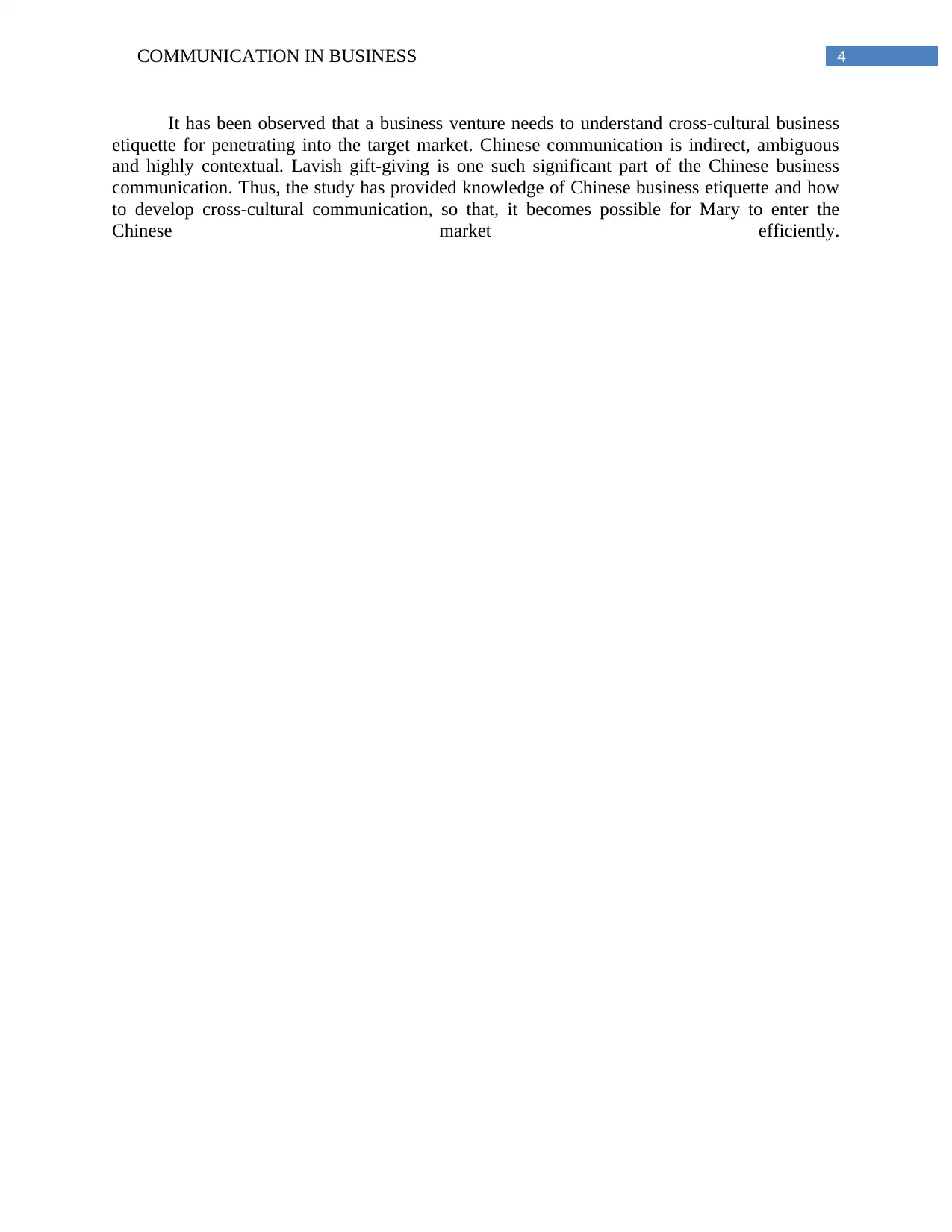
4COMMUNICATION IN BUSINESS
It has been observed that a business venture needs to understand cross-cultural business
etiquette for penetrating into the target market. Chinese communication is indirect, ambiguous
and highly contextual. Lavish gift-giving is one such significant part of the Chinese business
communication. Thus, the study has provided knowledge of Chinese business etiquette and how
to develop cross-cultural communication, so that, it becomes possible for Mary to enter the
Chinese market efficiently.
It has been observed that a business venture needs to understand cross-cultural business
etiquette for penetrating into the target market. Chinese communication is indirect, ambiguous
and highly contextual. Lavish gift-giving is one such significant part of the Chinese business
communication. Thus, the study has provided knowledge of Chinese business etiquette and how
to develop cross-cultural communication, so that, it becomes possible for Mary to enter the
Chinese market efficiently.
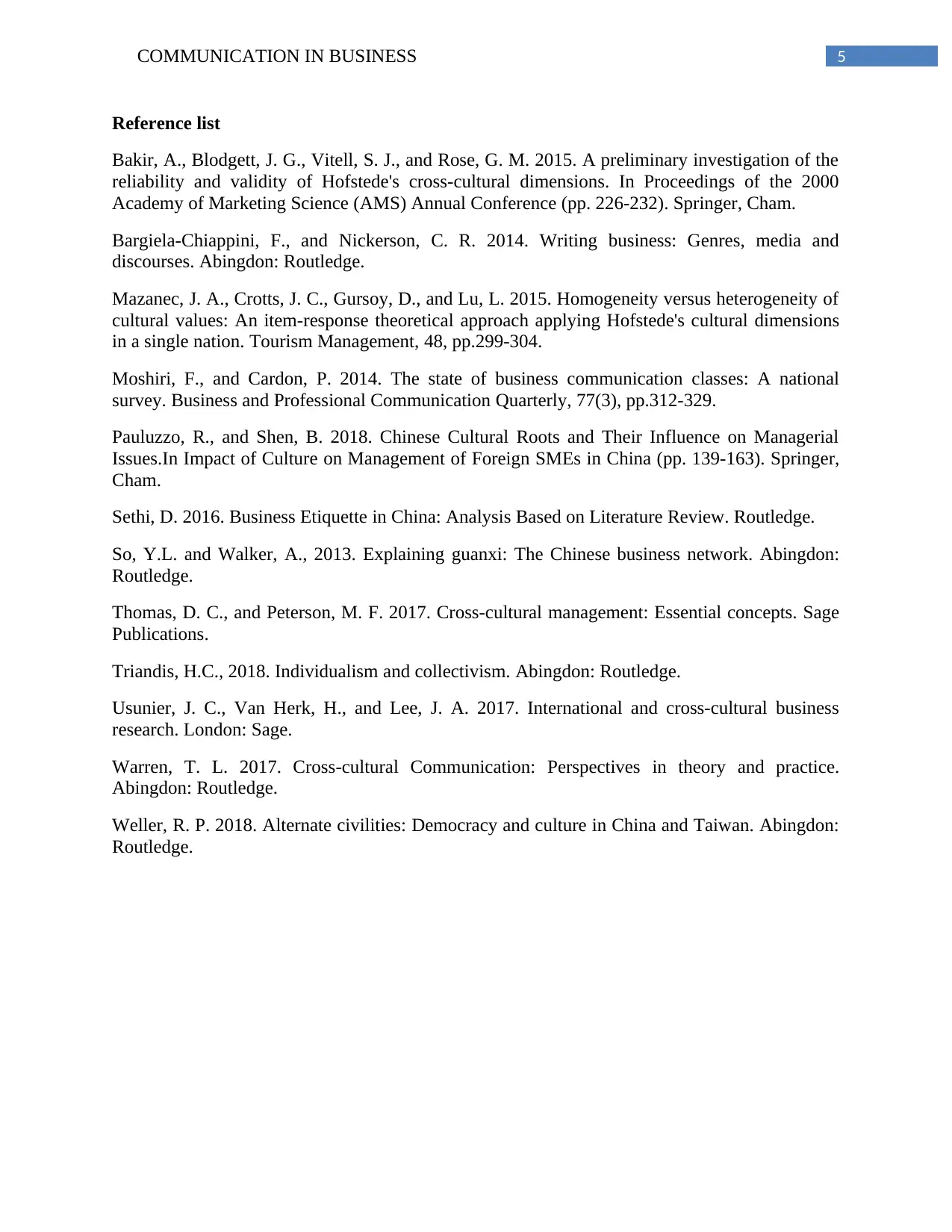
5COMMUNICATION IN BUSINESS
Reference list
Bakir, A., Blodgett, J. G., Vitell, S. J., and Rose, G. M. 2015. A preliminary investigation of the
reliability and validity of Hofstede's cross-cultural dimensions. In Proceedings of the 2000
Academy of Marketing Science (AMS) Annual Conference (pp. 226-232). Springer, Cham.
Bargiela-Chiappini, F., and Nickerson, C. R. 2014. Writing business: Genres, media and
discourses. Abingdon: Routledge.
Mazanec, J. A., Crotts, J. C., Gursoy, D., and Lu, L. 2015. Homogeneity versus heterogeneity of
cultural values: An item-response theoretical approach applying Hofstede's cultural dimensions
in a single nation. Tourism Management, 48, pp.299-304.
Moshiri, F., and Cardon, P. 2014. The state of business communication classes: A national
survey. Business and Professional Communication Quarterly, 77(3), pp.312-329.
Pauluzzo, R., and Shen, B. 2018. Chinese Cultural Roots and Their Influence on Managerial
Issues.In Impact of Culture on Management of Foreign SMEs in China (pp. 139-163). Springer,
Cham.
Sethi, D. 2016. Business Etiquette in China: Analysis Based on Literature Review. Routledge.
So, Y.L. and Walker, A., 2013. Explaining guanxi: The Chinese business network. Abingdon:
Routledge.
Thomas, D. C., and Peterson, M. F. 2017. Cross-cultural management: Essential concepts. Sage
Publications.
Triandis, H.C., 2018. Individualism and collectivism. Abingdon: Routledge.
Usunier, J. C., Van Herk, H., and Lee, J. A. 2017. International and cross-cultural business
research. London: Sage.
Warren, T. L. 2017. Cross-cultural Communication: Perspectives in theory and practice.
Abingdon: Routledge.
Weller, R. P. 2018. Alternate civilities: Democracy and culture in China and Taiwan. Abingdon:
Routledge.
Reference list
Bakir, A., Blodgett, J. G., Vitell, S. J., and Rose, G. M. 2015. A preliminary investigation of the
reliability and validity of Hofstede's cross-cultural dimensions. In Proceedings of the 2000
Academy of Marketing Science (AMS) Annual Conference (pp. 226-232). Springer, Cham.
Bargiela-Chiappini, F., and Nickerson, C. R. 2014. Writing business: Genres, media and
discourses. Abingdon: Routledge.
Mazanec, J. A., Crotts, J. C., Gursoy, D., and Lu, L. 2015. Homogeneity versus heterogeneity of
cultural values: An item-response theoretical approach applying Hofstede's cultural dimensions
in a single nation. Tourism Management, 48, pp.299-304.
Moshiri, F., and Cardon, P. 2014. The state of business communication classes: A national
survey. Business and Professional Communication Quarterly, 77(3), pp.312-329.
Pauluzzo, R., and Shen, B. 2018. Chinese Cultural Roots and Their Influence on Managerial
Issues.In Impact of Culture on Management of Foreign SMEs in China (pp. 139-163). Springer,
Cham.
Sethi, D. 2016. Business Etiquette in China: Analysis Based on Literature Review. Routledge.
So, Y.L. and Walker, A., 2013. Explaining guanxi: The Chinese business network. Abingdon:
Routledge.
Thomas, D. C., and Peterson, M. F. 2017. Cross-cultural management: Essential concepts. Sage
Publications.
Triandis, H.C., 2018. Individualism and collectivism. Abingdon: Routledge.
Usunier, J. C., Van Herk, H., and Lee, J. A. 2017. International and cross-cultural business
research. London: Sage.
Warren, T. L. 2017. Cross-cultural Communication: Perspectives in theory and practice.
Abingdon: Routledge.
Weller, R. P. 2018. Alternate civilities: Democracy and culture in China and Taiwan. Abingdon:
Routledge.
1 out of 6
Related Documents
Your All-in-One AI-Powered Toolkit for Academic Success.
+13062052269
info@desklib.com
Available 24*7 on WhatsApp / Email
![[object Object]](/_next/static/media/star-bottom.7253800d.svg)
Unlock your academic potential
© 2024 | Zucol Services PVT LTD | All rights reserved.




